The Endless Quest to Find the Perfect Note Taking Platform (2018 Edition)
Table of Contents
As I have written before, I’ve used just about every note solution around. Unfortunately I haven’t found a magic bullet (yet). This post is really an exploration into the pros and cons for my own personal workflow and this the things I find important when managing notes. Hopefully after doing this exploration I can actually settle on one platform for the long haul and stop procrastinating by switching note platforms and writing blog posts about it.
TL;DR: Jump right to the final scores
Now. With that out of the way…
What Do I Use Notes For #
I use notes for just about every context of my life, so the ability to separate them (by tags, folders or whatever) is super important. I draft blog posts, write long-form and also jot down quick to-do lists and random brain dumps of bullet points. I need something that can do it all, and keep it all in one place.
I have a pretty small list of reasonable requirements and yet, I frequently find myself repeatedly unsatisfied with the current offerings and therefore repeatedly switching platforms over and over.
Must-haves #
Any note platform which I am going to use seriously NEEDS to have all these things. There might be other features that are useful to me but I don’t consider them deal breakers if they are missing.
1. Markdown #
This by far and away my preferred writing format. It is flexible enough to allow for long form essays and big paragraph blocks or just simple bullet lists and probably among the most important to me: code blocks.
If markdown isn’t a first class citizen like in Bear or Typora it should at least be supported (e.g. SimpleNote). Most of my notes contain code snippets, but sometimes it’s just a small list of thoughts and occasionally long-form prose like a blog post draft.
2. Syncing #
These days we expect our data to be available everywhere at all times. I am no exception to this as I hop from one device to another many times a day.
Offline support is equally as important; needing to be online to see and write my notes is a total dealbreaker, one which brings me to my next requirement…
3. Cross-Platform Clients #
Any given day I swap between iPad, iPhone, Windows 10 and macOS depending on the context. I love to write blog post drafts on my phone for example (I wrote 90% of this blog post on my iPhone), but if I’m working on a personal coding side-project I’ll probably be on Windows and will want to have my notes available there as well.
Side note: To me, a web client does not constitute “cross-platform”. For my purposes, cross-platform means fat clients for Windows, macOS, iPhone and iPad. I can live without a Linux client today, but if Apple keeps up its recent trend of bad hardware, that might change…
4. Searching/Discoverability #
Hopefully this one is pretty self-explanatory. Notes are useless unless you’re going to read them later. If you can’t find them then you can’t read them!
In addition to the decent on-demand search feature, I really want some sort of organizational structure to keep my brain organized.
5. A Pleasant Writing Experience #
When writing markdown it’s nice to be able to see what you’re doing (live preview), and also if I start a bulleted list with a hyphen or asterisk it would be nice if the editor added a new one for me when I press enter, and then cancel out of the list if I press enter again without having typed anything.
Many editors have a sort of hybrid view where you see the actual markdown text but the bold parts are bold and the emphasized parts are italic. Bonus marks if it also hides the markdown characters when I’m not editing that word or paragraph.
Syntax highlighting is a real bonus as well since it makes code snippets so much more readable.
The Contenders #
I compared 6 different note taking solutions and gave them each a score out of 5 for each of the requirements. The max score is 25.
Apple Notes #
The Notes app is a go-to for many Apple users, and I used it myself for about 2 years. The seamless sync between Apple devices never goes wrong, the editor is nice (especially after they added Checklists) and it allows you to organize your plain text notes into folders.
Where it falls down is where every piece of Apple software falls down. It only works on Apple stuff. Yes there’s the iCloud webapp that you can use to edit your notes, but it feels like a second class experience.
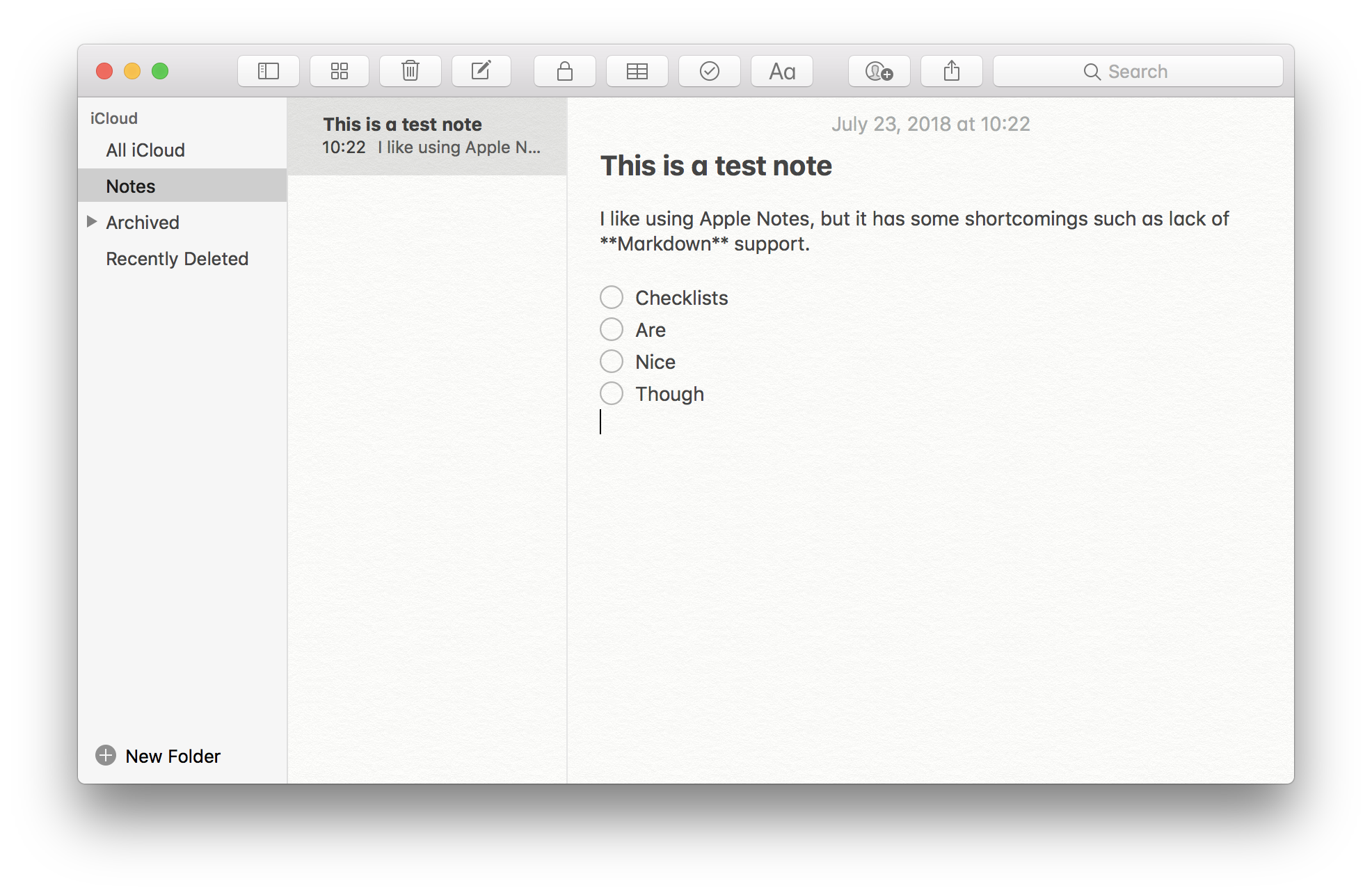
The lack of Markdown combined with the Apple walled garden syndrome was ultimately the reason I stopped using it.
Bear Writer #
Bear is a relatively new player on the scene. Created by a company called Shiny Frog, Bear offers a complete replacement for Apple Notes, and even uses the same iCloud-based syncing platform (if you pay for Pro). Where Bear shines is by bringing Markdown to the forefront. Bear gives you all the tools you need to write long form prose or just jot down quick todo lists and looks amazing while doing it.
The addition of Hashtags to organize your notes was a nice surprise and it actually worked really well for organizing many notes into a vague structure. Syntax highlighting was another really nice feature.
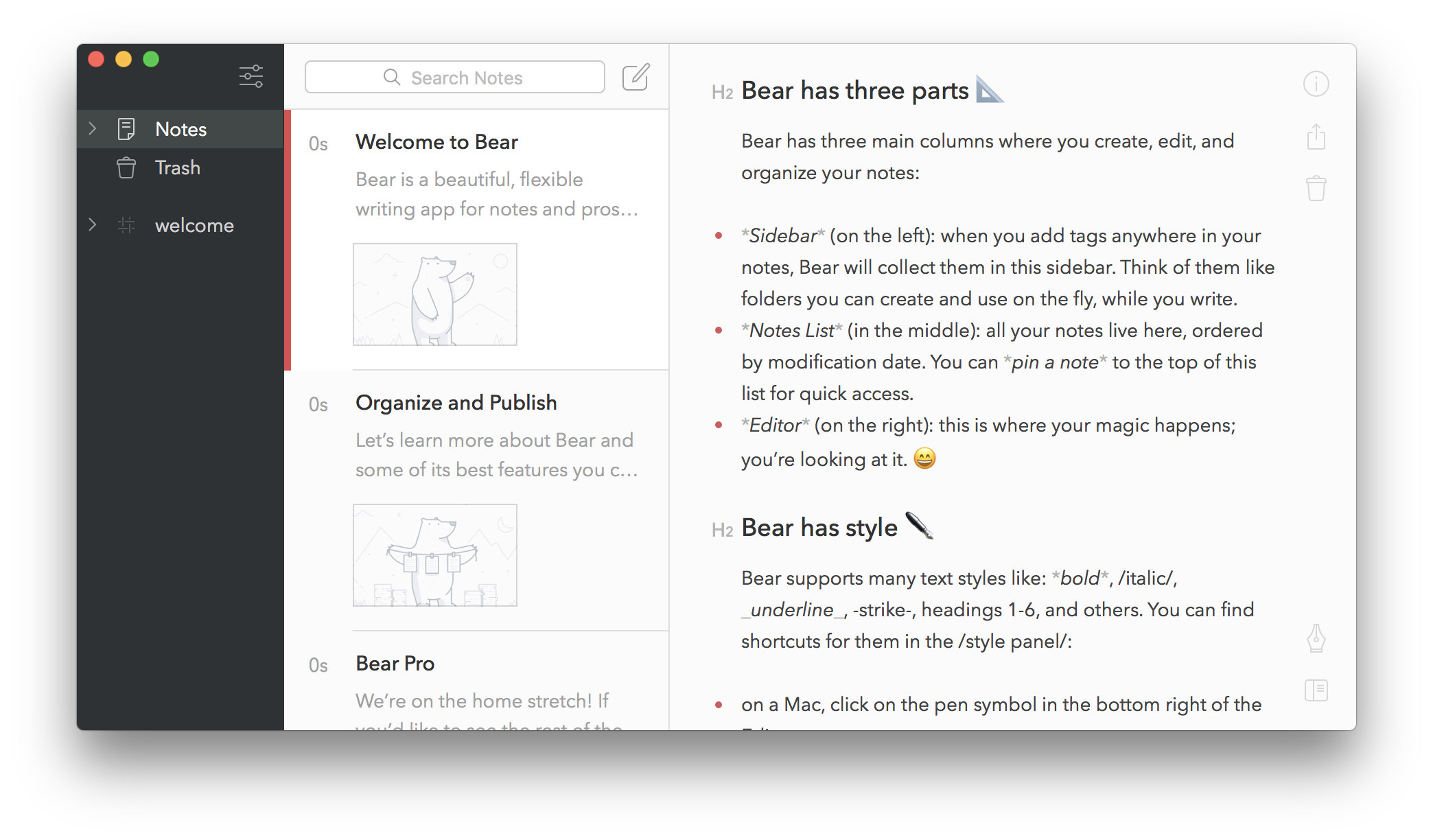
Bear and I had a great run, and I was a Pro users for a few months. In the end though, I ended up moving away from Bear because I was not a fan of how they mingle the Markdown syntax in with your content in such a way that I was never 100% sure what was going to come out when I used copy-paste. Additionally the financial angle, combined with lack of Windows support were the final nail in the coffin. I don’t mind paying for something like this, it’s just that there are other solutions that have similar feature sets but don’t cost anything.
Evernote #
Oh Evernote. I used to be a pretty heavy Evernote user in the 2010-2013 sort of timeframe. It has come a long way since then, but unfortunately it has also added a TON of new (and IMO unnecessary) features which bloat the clients to the point where I don’t enjoy using them.
Yes, Evernote has clients for every platform under the sun (except Linux teehee!) and the Syncing is pretty OK (have had conflicts go bad before). But I just can’t get past the enormity of features. When you boot up the Evernote desktop client these days you’re faced with an overwhelming amount of UI.
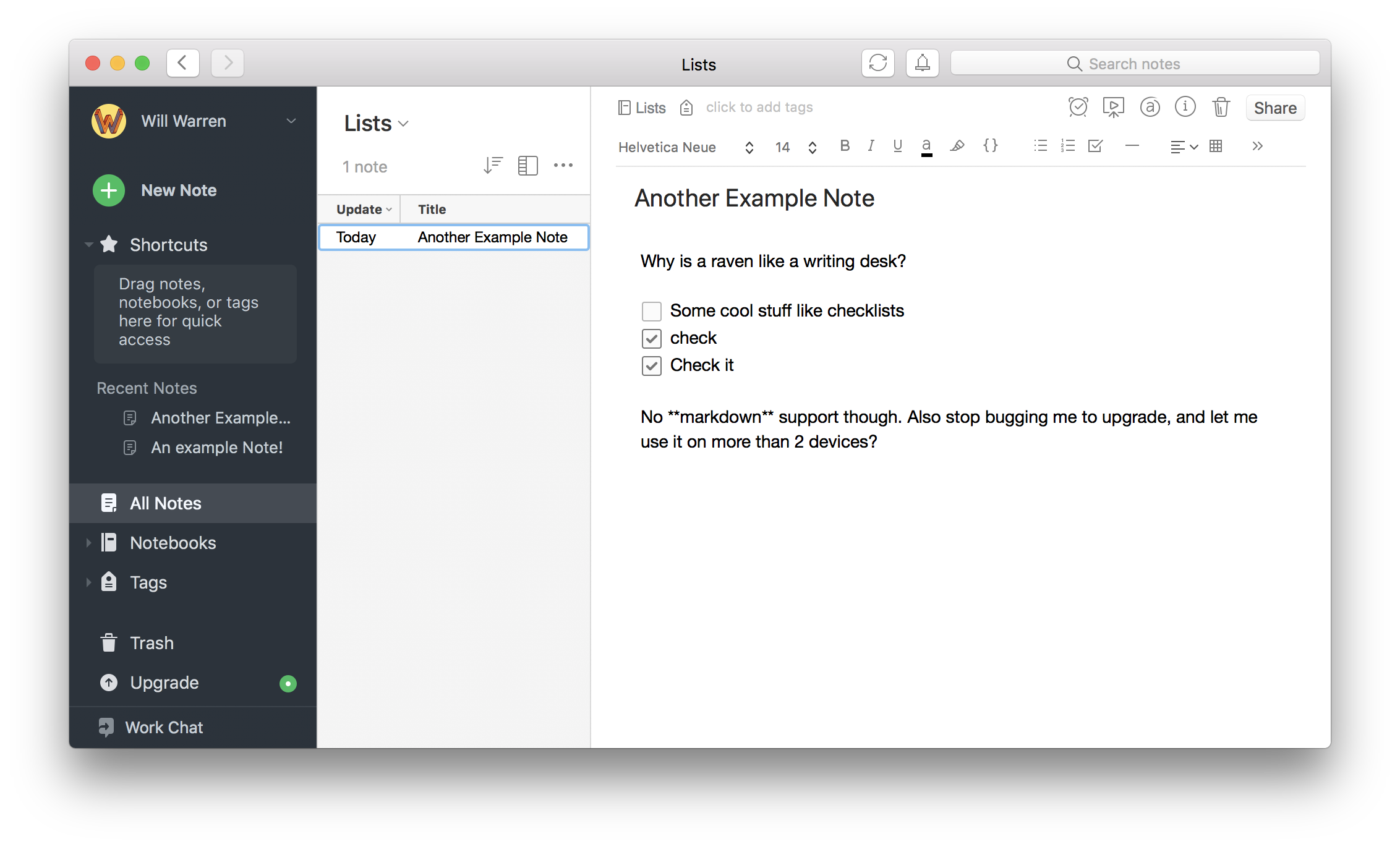
The note taking experience is pretty nice, however it seems like it went to the Microsoft Word school of word processing. If you copy a code sample from a note in Evernote, there’s a better than average chance that it will have turned all your hyphens into em-dashes, and all your double quotes into their slanty variants rendering the code useless.
Microsoft OneNote #
OneNote! It seems to have everything I want (except decent Markdown support), but somehow I just hate it. I think for someone who is in college doing a bunch of study type work it would be nice, because its note taking area is very free form - you can just click anywhere and start typing. It has many organizational tools (notebooks, sections, pages, oh my!) but IMO too many.
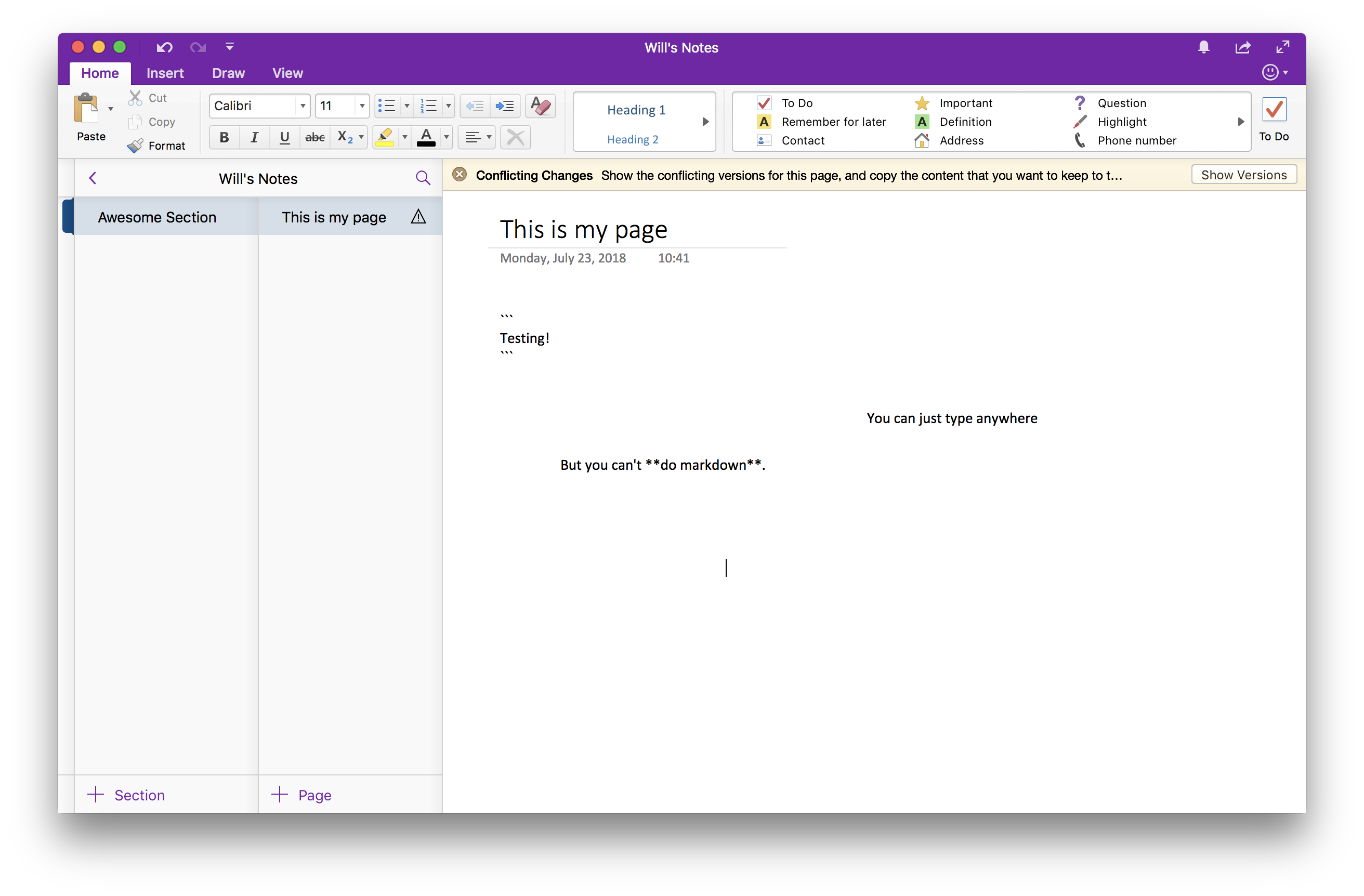
The clients are nice, but since they are anchored to Microsoft’s online services, you’ll have a hell of a time due to slowness, and having to constantly re-login etc. OneNote also suffers from the same issue that Evernote has re: copy-pasting stuff and having it change on you. In addition to these points there’s also the issue of bloat.
SimpleNote #
I like SimpleNote a lot. FULL DISCLAIMER: it is currently my note-taking solution of choice. It is free, has seamless syncing, clients on every platform and Markdown support.
So that’s all great - but where it falls down is the editor. It’s pretty much just a plain text editor where you can click a button to see the Markdown preview. Yes it has a bit of the hybrid markdown stuff going on (bold stuff is bold for example) but when it comes to lists and things it starts to fall apart.
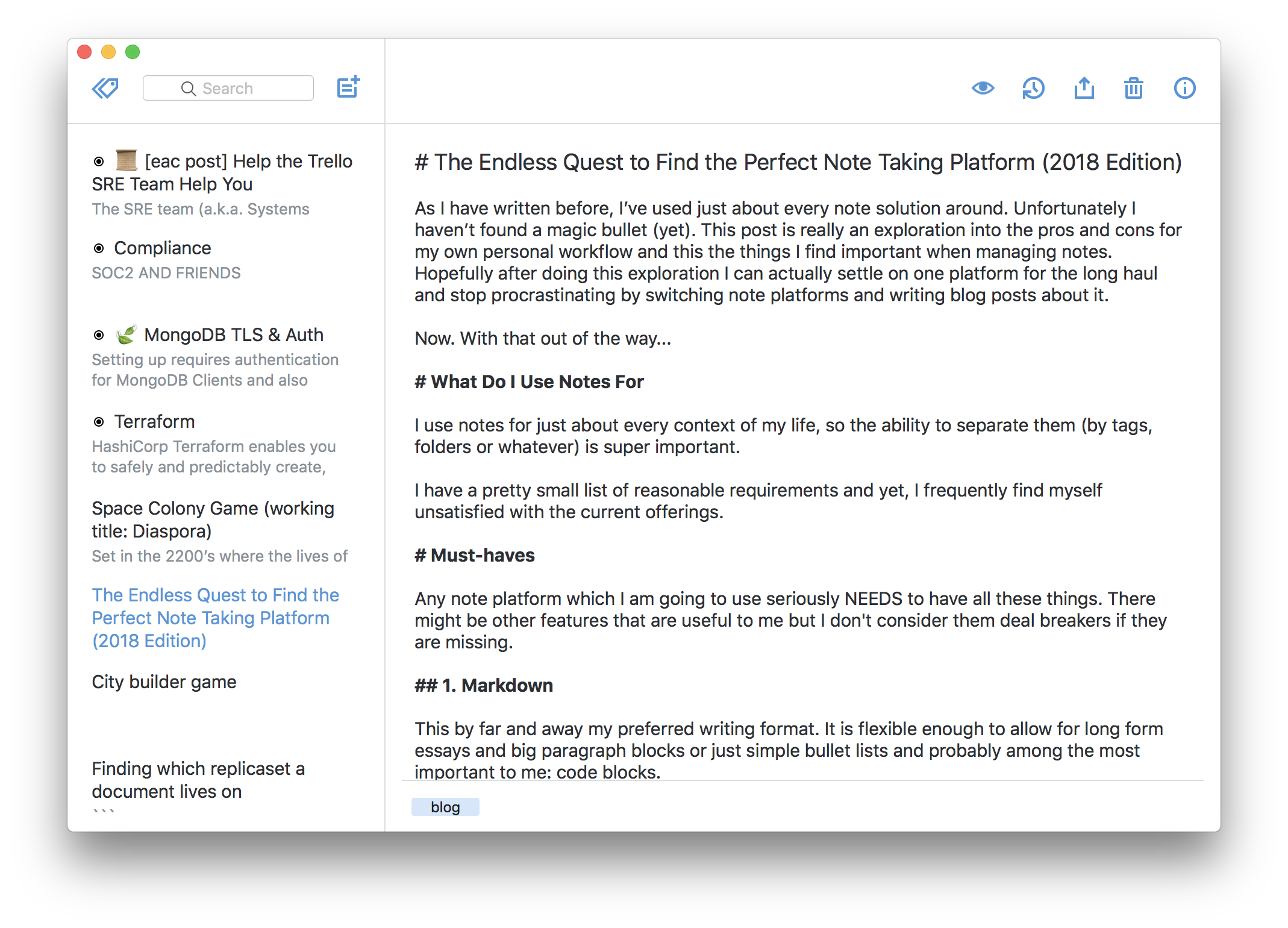
The Syncing is rock solid - it is built on top of Simperium and I’ve never had an issue. Same goes for the Searching. Realistically, if you look at my whole list of must-haves it hits every single one. I just wish they would fix the editor so that it was a bit more user friendly. If they did that I think they would absolutely destroy all competition immediately. Make it so my Mom can write markdown without realizing she’s doing it.
Typora #
OK, this is not a note-taking “solution” per se. Typora is simply a Markdown editor and reader for .md files but WHAT AN EDITOR! Really, it’s the best markdown experience I’ve ever had. It even supports tables and .sequence diagrams and is FREE (for now). What’s more, the markdown live preview is second to none. There’s no switching between preview and edit mode, you just write markdown, and it does the rest. So you can actually edit while previewing in-line!

So what can we do to make it more useful? Well combined with Dropbox, Typora’s ability to open a whole folder instead of just individual files - you’ve got a cross-platform (electron) fully-synced note-taking platform. There’s no mobile client that has the same capabilities as Typora (that I have found) but theoretically you could open the files with any mobile Markdown editor since they are just loose files.
The Scores #
And the winner is…
| Platform | Markdown | Syncing | Clients | Search | Pleasant | Total |
|---|---|---|---|---|---|---|
| SimpleNote | 4 | 5 | 5 | 5 | 4 | 23 |
| Bear Writer | 4 | 5 | 3 | 5 | 4 | 21 |
| Typora (w/ Dropbox) | 5 | 5 | 2 | 2 | 5 | 19 |
| Apple Notes | 0 | 5 | 3 | 5 | 4 | 17 |
| Evernote | 0 | 5 | 4 | 5 | 3 | 17 |
| Microsoft OneNote | 0 | 4 | 4 | 4 | 2 | 14 |
So SimpleNote is the winner! That makes a lot of sense. Bear came in a very close second because the writing experience and syncing are so great. But falls down on cross-platformness. The three that I tested that don’t even support Markdown obviously ended up in the bottom 50% since they scored a 0 in that category. The reason I only scored SimpleNote and Bear a 4 for Markdown is because I had to adjust the scale for Typora’s insane markdown support. Sequence diagrams. Seriously.
Conclusion #
If I were to weight each of the categories that I scored it in, I think Typora would probably emerge the winner. The writing experience means a lot more to me than I originally thought when I started this exploration. So much that I’m willing to overlook the fact that there’s no mobile client, and no built-in syncing.
If we could simply strap Typora’s interface onto SimpleNote’s backend, you would have the note-taking solution to end all note-taking solutions. I would pay good money for that without hesitation.
Bear is really really good, and for people who are all-in on the Apple ecosystem then I would HIGHLY recommend it. Unfortunately since they have bound themselves to the iCloud syncing backend, it suffers from the same shortcomings as the free, built-in Apple Notes app. All Apple has to do is add Markdown support and poof, Bear has lost its niche.
For now, I’m going to continue using SimpleNote, but I won’t lie - I also use Typora/Dropbox quite a bit still, especially when writing blog drafts. So when thoughts hit me and I’m out and about, I still fire up the SimpleNote mobile app because it’s always there and works so well, but if I’m sitting at a computer and have more time, Typora is where its at. Yes, this means that all my stuff is split across 2 different places, but all that really means is that I have more ammunition for the 2019 edition of this blog post.